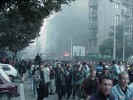5. The Mind-set of Racism and Lies
The jargon is symptomatic of pseudo-speciation,
the mind-set of racism which groups automatically adopt to sustain their belief systems.
Even a former US Ambassador to NATO, speaking on BBC TV in the UK on April 22, 1999, said
that NATO must dispose of the last pocket of communism in Europe before European progress
could continue. If that is so, then Albania — the new ally of
NATO — should worry: it still sustains, where it has any government at all, a
communist structure by any other name.
So, too, does Croatia, which prides itself on being
philosophically in the camp of Western Europe. Croatia, despite the fact that it
has had less external constraint than Yugoslavia, has achieved far less in the way of
privatization of commerce and industry. Croatia is a State-dominated
economy, with dramatically less freedom of speech, movement and religion, than is
Yugoslavia.
And yet the impression of Yugoslavia as a "communist bastion" is being
perpetuated in the West. The Yugoslav populace is baffled by the West’s view of it,
and as reluctant as it is to embrace the friendship of Russia, it feels that it has little
option: the Orthodox peoples must stay together in the face of anti-Orthodox hatred. This complements the belief among many in Yugoslavia that the Vatican is
heavily-involved in the attempt to isolate them.
Such a belief is not unreasonable given the rôle of the Catholic Church in Croatia
during World War II. But then, the Croatian Catholic church is barely recognizable as the
same faith practiced elsewhere. But when German Catholics spearheaded the funding and
military aid for Croatia before and after the break-up of Yugoslavia in 1991-92, the old
fears of the Serbs returned. They had lost 1.7-million of their
people to Croatian "ethnic cleansing" (the phrase is a Croatian one) in the
Croatian Ustaše concentration camps and summary killings of 1941-45. The
Serbs, along with the Jews they tried to protect, were among the proportionately greatest
victims of World War II.
The fact that Clinton insisted on keeping up the bombing campaign
through Orthodox Easter inevitably made Serbs draw parallels with the nazis in World War
II. It was on April 6, 1941, Palm Sunday, that the Luftwaffe bombed Belgrade
when the Yugoslavs hesitated to surrender. Some 5,000 people died, virtually all
civilians.
For a comprehensive understanding of this era it is necessary to read, among other
things, The Web of Disinformation: Churchill’s Yugoslav Blunder, by
the late David Martin [Published by Harcourt Brace Jovanovich in 1991]. Read it, and weep.
The endless trail of disinformation, or just plain lies,
continues at all levels during the current conflict. In 1992, when this writer was
visiting Yugoslavia on one of the many assignments into the conflict zone, he was told
repeatedly by Serbs: "We know that the truth will come out and that people will
remember that we have always been the allies of the West, and that we would never do the
things the media is saying about us."
History is written by the winners, however; and victory is as much the product of the
pen as of the sword. The US, hoping to obtain a bargaining tool to
win the release of the three US soldiers held captive as Prisoners of War by the
Yugoslavs, sent a mission inside Yugoslavia in April 1999 to capture a Yugoslav officer.
This they did, snatching a 20-year-old lieutenant. But the US
Government, unwilling to admit to having ground forces inside Yugoslavia, said that the
KLA had captured the officer and turned him over to the US. A
small lie, but one which points to the fact that the Clinton
Administration is reluctant to admit the forward posture of its ground forces.
State Department spokesman James Rubin, who is married to CNN
television news reporter Christiane Amanpour, constantly talks of "compelling
evidence" of "Serb atrocities", but in fact
never actually details the "compelling evidence".
In some case, circumstantial evidence is shown, and then later the
"conclusions" from this evidence are portrayed as coming from incontrovertible
proof.
The "compelling evidence" of vast atrocities is not evident on the ground, other than the tragedy
of the scattering of refugees which began when the bombing of their places of work and
their homes began. Paul Watson, a Pulitzer Prize-winning Canadian journalist with The
Los Angeles Times, is one of the few reporters actively covering events on the ground
on Kosovo, where he was already in place when the bombing began on March 24. In an interview with Canadian Broadcasting radio on April 13, 1999, he
said: "It is very hard to hide an anarchic wholesale slaughter of people. There is no
evidence that such a thing happened in Pristina [the Kosovo capital]." "I have
spoken personally to people who have been ordered to leave their homes by police in black.
I’ve also spoken to people who are simply terrified." He added: "I see a pretty clear pattern of refugees leaving an area after there were
severe air strikes." Not just in Kosovo, but all over Yugoslavia. This writer
has also seen refugees on the move, their red tractors pulling carts with families aboard,
leaving places such as Pancevo after the bombings; trying to find a place in the country
away from the war.
Watson noted: "I do not think that NATO member countries
can, with a straight face, sit back and say they don’t share some of the blame for
the wholesale depopulation of the country. If NATO had not bombed, I would be surprised if
this sort of forced exodus on this enormous scale would be taking place."
NATO spokesman and US State Department spokesman James Rubin
picked up, on March 29, on reports that three key Kosovo Albanian leaders, one of whom was
involved in the negotiations over Kosovo at Rambouillet had been "executed" by
Serb forces. Rubin said that the US would "avenge" their deaths. However,
the three —Fehmi Agani, who was at Rambouillet; Baton Haxhiu,
editor of Koha Ditore, a Kosovo Albanian news-paper; and Dr Ibrahim Rugova, the
only elected leader of the Kosovo Albanians —were all
very much alive. Dr Rugova, in particular, was seen on television on many occasions
following the allegation, and the UN High Commissioner for Refugees reported on the safety
of the others. Neither Rubin nor NATO amended their story; Rubin, even after the news of the three mens’ continued well-being,
still insisted on "avenging their deaths".
Given the earlier (1997) plan by the KLA to kill the moderate
Rugova, it would seem that the lives of these three Kosovo Albanian leaders is in
danger again, from the KLA. Certainly, the US has backed KLA-leaked reports that Dr Rugova
is "a virtual prisoner" of the Yugoslav Government, something he effectively
seems (as at this writing in late April 1999) to disavow every time he is seen in public
in Belgrade.
Perhaps one of the biggest
"tactical lies" being perpetuated as the bombing
campaign continues was the failure by the US and NATO to announce their own battlefield
casualties. If the US is to be believed, it has lost only one aircraft in the war
(to April 25, 1999). The reality is that far more aircraft had already been lost by NATO
to that point. Aircrews and ground troops had been killed and captured, according to
reliable intelligence reaching this journal. The specific details
are discussed below, but, if verified, this means that the Chairman of the US Joint Chiefs
of Staff lied under oath in his testimony in April before the US Congress.


